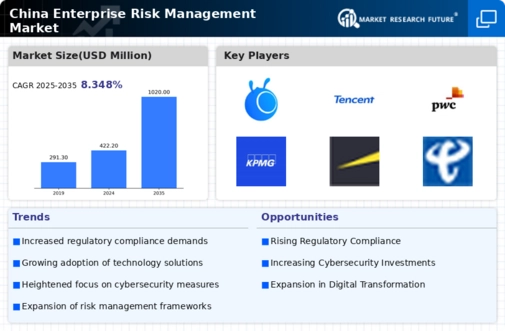Rising Cybersecurity Threats
The enterprise risk-management market is significantly influenced by the escalating threats posed by cyberattacks in China. With the rapid digital transformation across industries, organizations are increasingly vulnerable to data breaches and cyber threats. In 2025, it is projected that cybersecurity incidents will lead to losses exceeding $10 billion annually for Chinese enterprises. This alarming trend necessitates the implementation of robust risk management strategies to safeguard sensitive information and maintain operational integrity. Consequently, the demand for specialized risk management solutions tailored to address cybersecurity challenges is expected to grow, thereby propelling the enterprise risk-management market forward.
Regulatory Compliance Pressure
The enterprise risk-management market in China is experiencing heightened pressure due to stringent regulatory compliance requirements. Government agencies are increasingly mandating organizations to adopt comprehensive risk management frameworks to mitigate potential financial and operational risks. This regulatory landscape compels businesses to invest in advanced risk management solutions, thereby driving market growth. In 2025, it is estimated that compliance-related expenditures will account for approximately 30% of total risk management budgets. As organizations strive to align with evolving regulations, the demand for effective enterprise risk-management solutions is likely to surge, fostering innovation and enhancing the overall market landscape.
Growing Awareness of Environmental Risks
The enterprise risk-management market in China is increasingly shaped by the growing awareness of environmental risks and sustainability concerns. As climate change and environmental degradation become pressing issues, organizations are compelled to integrate environmental risk assessments into their risk management frameworks. This trend is likely to drive the demand for solutions that address environmental, social, and governance (ESG) factors. By 2025, it is estimated that enterprises will allocate around 20% of their risk management budgets to initiatives focused on environmental sustainability. This shift reflects a broader recognition of the interconnectedness of environmental risks and business viability, thereby influencing the enterprise risk-management market.
Increased Focus on Operational Resilience
In the current landscape, the enterprise risk-management market is witnessing a pronounced emphasis on operational resilience among Chinese organizations. Businesses are recognizing the importance of maintaining continuity in the face of disruptions, whether from natural disasters, supply chain interruptions, or other unforeseen events. As a result, investments in risk management frameworks that enhance resilience are on the rise. It is anticipated that by 2025, organizations will allocate approximately 25% of their risk management budgets towards initiatives aimed at strengthening operational resilience. This shift not only enhances risk mitigation strategies but also positions enterprises to thrive in an unpredictable environment.
Technological Advancements in Risk Assessment
Technological advancements are playing a pivotal role in transforming the enterprise risk-management market in China. The integration of artificial intelligence, machine learning, and data analytics into risk assessment processes is enhancing the accuracy and efficiency of risk identification and mitigation strategies. Organizations are increasingly leveraging these technologies to gain insights into potential risks and make informed decisions. By 2025, it is projected that investments in technology-driven risk management solutions will constitute approximately 35% of total market expenditures. This trend not only streamlines risk management processes but also empowers organizations to proactively address emerging risks, thereby shaping the future of the enterprise risk-management market.




















Leave a Comment